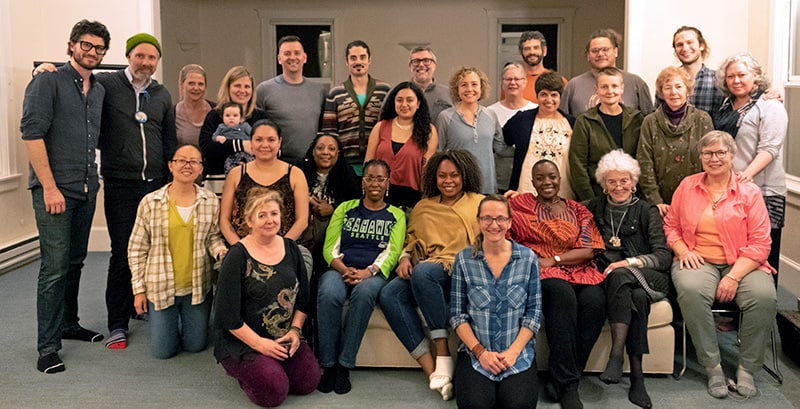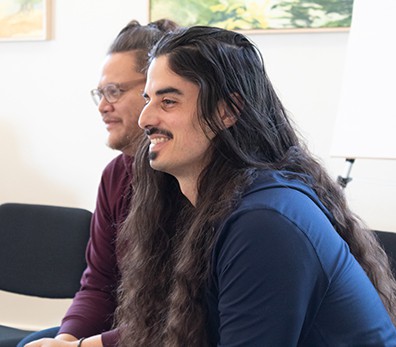by Ben Scott-Brandt, Coordinator, Retreat Center Collaboration
It’s February at Commonweal, when the sunlight filters through the heavy branches over the path, warming my spirit and the fragrant shoreline. That’s how I remember it at least. I’ve only been on the land at Commonweal once, for a four-day visit, exactly a year ago, in the Before Times.
I was coordinating a retreat for thirty retreat center leaders and allies from around the United States and Canada, as part of Roots to Reach, a pilot project of the Retreat Center Collaboration. With the support of the Fetzer Institute, we were convening to begin an experiential journey of deep transformation toward greater justice and equity in the retreat center sector.
Those four days were jubilant and hurried for me — brewing coffee in a giant aluminum urn, running the paths on errands between buildings, taking photographs of nodding lilies and our makeshift community altar, setting out chairs in the gallery for a large circle of new faces.
I’d just been hired to this coordinator role at Commonweal, choosing to upend my previous career in my home state of Michigan, where I’ve spent 16 years building relationships behind the chair as a hairstylist. Incidentally, hairstyling also includes brewing coffee, running errands, and making space for new faces. I began to feel right at home. Mornings at Commonweal were quiet. The evening meals were boisterous! And new relationships began to take shape.
In the months that followed, of course, very few of us felt right at home. Our new relationships became virtual connections. Retreat centers shifted and contracted during the pandemic, shelter-in-place restrictions sometimes made even our virtual gatherings uneasy, and wildfires imperiled or destroyed parts of several retreat centers in our larger community.
At times, the loss has felt palpable to me. Places like Commonweal change us; they have the space and intention to bring us back to ourselves, and thereby to deeper and richer life with one another. We cannot afford to lose them, and yet here I was, filling in a spreadsheet with the names of retreat centers that had closed, or were in danger of closing.
After the scramble of the early days of the pandemic, I’ve found a greater capacity in myself to sit with the questions. Questions of land, justice, healing, transformation, spirit, community, identity, and collaboration are woven into each of our conversations. The work play of collaboration and emergent organization revolves around questions. Curiosity. Imagining what’s possible.

My growing awareness—of the sector, of the challenges that retreat centers face, and of my role as a network weaver—gives my questions new edges. Growing edges. What is alive at retreat centers? What is dying? And how can I help?
This week Commonweal Executive Director Oren Slozberg posed a similar question, as we look to retreat centers as anchoring sites for the work of racial justice and healing: What is the unique fingerprint of retreat centers that makes transformation possible?
As an adult learner, I recently completed my undergrad degree in Integrative Studies, choosing “sacred space” as my focus area. I took philosophy and religious studies courses, pulled weeds and picked vegetables (sometimes contemplatively!) during my internship at two retreat centers, and facilitated a year of interfaith conversations and programs among fellow students. Throughout these experiences, I followed a central question. How do we create and tend ‘sacred’ spaces, both inside and outside the boundaries of religion?
In many ways, this is the question of retreat centers, and there are more answers than I can share here. Perhaps there are more answers than we can know. No two centers are alike, and the sector, the field, is expansive and multi-faceted. We may not agree on what is sacred, or on how to create space that’s deeply meaningful, but across the continent you’ll find retreat centers hold a sparkling menagerie of answers.
I recently began mapping our community, both as a network and geographically, with data drawn from a recent community survey and concentrated outreach. Our collaboration brings together voices from red and blue states, from inland and coastal provinces, from ancient traditions and new visions. Retreat centers in our community may operate within very different budgets and governance models from each other, but are coming together in a spirit of collaboration, around shared values that resonate across these differences.
What becomes possible as this community begins to understand itself and its own potential?
How exciting to learn together!
This week the Retreat Center Collaboration’s steering committee gathered online for a virtual retreat. Online gathering just isn’t the same, and although I led a walking meditation to start one of our sessions, I admit I often find it difficult to settle into the space. I missed sharing breakfast, seeing the fog and dew evaporate from the grasses, and piling our shoes outside the gallery door at Commonweal—but our time together was restorative.
The vital questions and this emergent community are still very alive, with growing edges that are curious, uncomfortable, and transformative. We spoke of abundance, of pedagogies and epistemologies, of current work and future gatherings, of the fingerprint of retreat centers.
As the day came to a close, we sang together in our Zoom grid, “here comes the sun! doo-n-doo-doo,” and our splintered voices filtered through screens and headphones, a collage of audio and video, smiles, and laughter. The chairs may not be set up in the gallery, but the faces are here, learning and curious, together.
